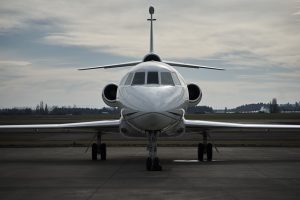
Modern airplanes are equipped with a variety of airflow control devices on their wings. Most airplanes have slats and flaps, for instance. Slats are hinge-like devices on the leading edge of an airplane’s wings, whereas flaps are hinge-like devices on the trailing edge While not as common as slats and flaps, some airplanes feature wing fences as well. What are wing fences, and how do they work?
Overview of Wing Fences
Wing fences are airflow control devices found on the upper surface of an airplane’s wings. Also known as boundary layer fences, they consist of a raised plate that extends about halfway to three-quarters of the way down the wings.
Wing fences are typically found near the leading edge. Wing fences start at the leading edge and run backward toward the trailing edge.
The Purpose of Wing Fences
Wing fences are designed to make airplanes more aerodynamic. Not all airplanes have them, however. Rather, wing fences are typically found on airplanes with swept wings.
Swept wings involve the wings of an airplane being angled backward. Many high-speed airplanes, such as jets, use this design for their wings. The problem with swept wings, however, is that it promotes spanwise airflow. The air will flow from sideways across the wings. Wing fences obstruct spanwise airflow such as this to improve the aerodynamics of swept-wing airplanes.
How Wing Fences Work
While other wing devices are adjustable — meaning the pilot can raise or lower them — wing fences are not. Wing fences are entirely fixed and offer no control mechanism. How do they work exactly?
Airplanes with swept wings are susceptible to spanwise airflow. Rather than moving over the wings, airflow will move sideways towards the wingtips. Spanwise airflow is particularly common when airplanes fly at a high angle of attack. If left unchecked, it can harm the airplane’s performance by reducing lift and increasing the risk of stalls.
Wing fences essentially act as vertical air barriers. They obstruct spanwise airflow so that the air can’t flow toward the wingtips. Upon striking a wing fence, the air will change its direction. Rather than moving sideways, the air will move backward.
Stalls can lead to a loss of lift while also making the airplane difficult to control. Wing fences help to prevent stalls by keeping the airflow on the wings for a longer period. When stalls occur, the airflow separates from the lifting surfaces. Wing fences can prevent stalls by redirecting the air along the wings.



